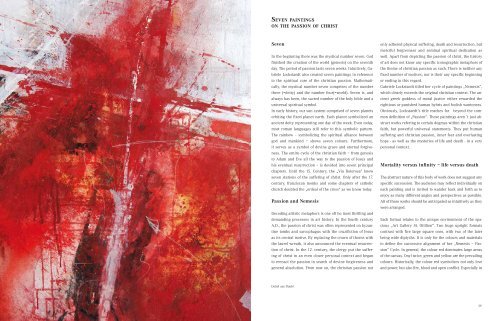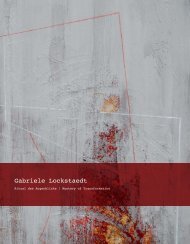Gabriele Lockstaedt NEMESIS
Gabriele Lockstaedt NEMESIS
Gabriele Lockstaedt NEMESIS
Sie wollen auch ein ePaper? Erhöhen Sie die Reichweite Ihrer Titel.
YUMPU macht aus Druck-PDFs automatisch weboptimierte ePaper, die Google liebt.
Seven paintings<br />
on the passion of christ<br />
Seven<br />
In the beginning there was the mystical number seven. God<br />
finished the creation of the world (genesis) on the seventh<br />
day. The period of passion lasts seven weeks. Intuitively, <strong>Gabriele</strong><br />
<strong>Lockstaedt</strong> also created seven paintings in reference<br />
to the spiritual core of the christian passion. Mathematically,<br />
the mystical number seven comprises of the number<br />
three (=deity) and the number four(=world). Seven is, and<br />
always has been, the sacred number of the holy bible and a<br />
universal spiritual symbol.<br />
In early history, our sun system comprised of seven planets<br />
orbiting the fixed planet earth. Each planet symbolized an<br />
ancient deity representing one day of the week. Even today,<br />
most roman languages still refer to this symbolic pattern.<br />
The rainbow - symbolizing the spiritual alliance between<br />
god and mankind – shows seven colours. Furthermore,<br />
it serves as a symbol of devine grace and eternal forgiveness.<br />
The entire cycle of the christian faith – from genesis<br />
to Adam and Eve all the way to the passion of Jesus and<br />
his eventual resurrection – is devided into seven principal<br />
chapters. Until the 15. Century, the „Via Dolorosa“ knew<br />
seven stations of the suffering of christ. Only after the 17.<br />
century, franziscan monks and some chapters of catholic<br />
church doubled the „ordeal of the cross“ as we know today.<br />
Passion and Nemesis<br />
Decoding artistic metaphors is one oft he most thrilling and<br />
demanding processes in art history. In the fourth century<br />
A.D., the passion of christ was often represented on byzantine<br />
tombs and sarcophagus with the cruzifiction of Jesus<br />
as its central motive. By replacing the crown of thorns with<br />
the laurel wreath, it also announced the eventual resurrection<br />
of christ. In the 12. century, the clergy put the suffering<br />
of christ in an even closer personal context and began<br />
to reenact the passion in search of devine forgiveness and<br />
general absolution. From now on, the christian passion not<br />
only adhered physical suffering, death and resurrection, but<br />
merciful forgiveness and seminal spiritual dedication as<br />
well. Apart from depicting the passion of christ, the history<br />
of art does not know any specific iconographic metaphors of<br />
the theme of christian passion as such. There is neither any<br />
fixed number of motives, nor is their any specific beginning<br />
or ending in this regard.<br />
<strong>Gabriele</strong> <strong>Lockstaedt</strong> titled her cycle of paintings „Nemesis“,<br />
which clearly exceeds the original christian context. The ancient<br />
greek goddess of moral justice either rewarded the<br />
rightious or punished human hybris and foolish wantoness.<br />
Obviously, <strong>Lockstaedt</strong>’s title reaches far beyond the common<br />
definition of „Passion“. These paintings aren´t just abstract<br />
works refering to certain dogmas within the christian<br />
faith, but powerful universal statements. They put human<br />
suffering and christian passion, inner fear and everlasting<br />
hope - as well as the mysteries of life and death - in a very<br />
personal context.<br />
Mortality versus infinity – life versus death<br />
The abstract nature of this body of work does not suggest any<br />
specific succession. The audience may reflect individually on<br />
each painting and is invited to wander back and forth as to<br />
enjoy as many different angles and perspectives as possible.<br />
All of these works should be anticipated as intuitively as they<br />
were arranged.<br />
Each format relates to the unique environment of the spacious<br />
„Art Gallery St. Ottilien“. Two huge upright formats<br />
contrast with five large square ones, with two of the later<br />
being wide diptychs. It is only for the colours and materials<br />
to define the successive alignment of her „Nemesis – Passion“<br />
Cycle. In general, the colour red dominates large areas<br />
of the canvas. Onyl twice, green and yellow are the prevailing<br />
colours. Historically, the colour red symbolizes not only love<br />
and power, but also fire, blood and open conflict. Especially in<br />
Detail aus Doubt<br />
38 39



